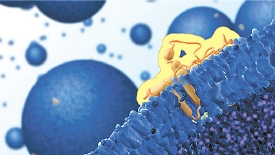Dec 16 2008
Tiny self-assembling metal cubes dance across the screen in a video posted on the Web site of the Johns Hopkins Institute for NanoBioTechnology. You could read a book — or at least several chapters — on the principles behind how these microcubes build themselves up from microscopic metallic sheets cut by lasers. Or you could watch a one-minute animated video that tells their fantastic story.
 This image from an animation created by Ammon Posey, Martin Rietveld and the Hill Lab depicts a Bcl-XI protein creating a pore in a lipid vesicle.
This image from an animation created by Ammon Posey, Martin Rietveld and the Hill Lab depicts a Bcl-XI protein creating a pore in a lipid vesicle.
The INBT video of the self-assembling cubes is the result of the independent study course Animation in Nanotechnology and Medicine and was produced under the guidance of INBT animation/Web director Martin Rietveld, who shares his skills and experience in 2-D/3-D animation with students from throughout Johns Hopkins who want to learn to use this lively medium.
INBT's animation studio and the independent study course have attracted students from the basic sciences, engineering, the School of Medicine's Department of Art as Applied to Medicine and the Krieger School's Writing Seminars, to name a few. Some students understand the science; others are skilled in illustration or other types of visualization. "My job is to try to guide these forces into something that actually produces a movie," Rietveld says.
Students who sign up for the course should be aware of the time commitment involved in order to produce a film as well executed as the current productions, Rietveld says. Presently, there are two animated movies on the INBT Web site demonstrating the research of INBT-affiliated faculty members. One explains the self-assembling cubes used in the research of David Gracias, assistant professor of chemical and biomolecular engineering in the Whiting School of Engineering, and the other shows the interaction between a protein and a lipid bilayer, based on the work of Blake Hill, associate professor of biology in the Krieger School of Arts and Sciences.
Rietveld recommends that before students start the course, they should be somewhat familiar with animation software. They learn about the science they intend to animate by interviewing the scientists and engineers engaged in the research. Students then shift their attention to production, storyboarding and animation. Eventually, they'll do post-production and audio work. Projects are completed using INBT's computers and software. For specific tasks, such as recording video and audio, INBT collaborates with the Digital Media Center and the Center for Educational Resources.
"It can take at least two semesters, and students in the course are expected to put in at least 10 hours per week to complete a project," Rietveld says. The 3-credit independent study course does not necessarily adhere to a fixed schedule, so students need to have a lot of self-motivation, Rietveld adds.
"It takes a long time to produce something of quality, [and] it is difficult to achieve this kind of artistic integrity while maintaining scientific accuracy," Rietveld says, "but that is why working in this kind of animation is challenging and fun."